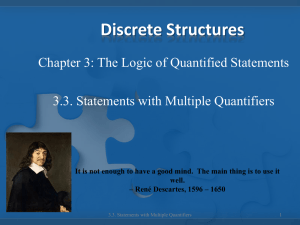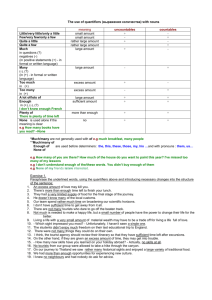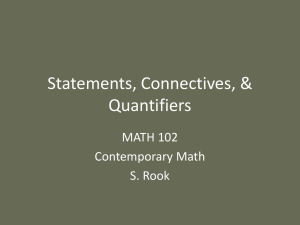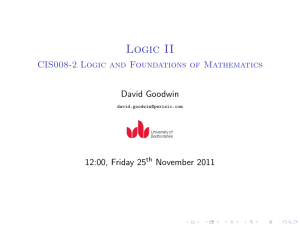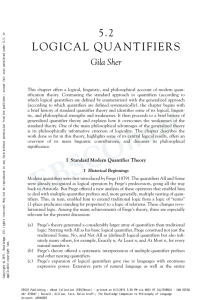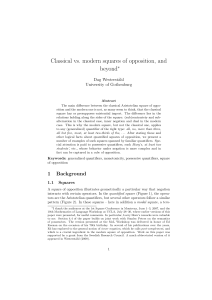0.2 Quantifiers and Negation
advertisement
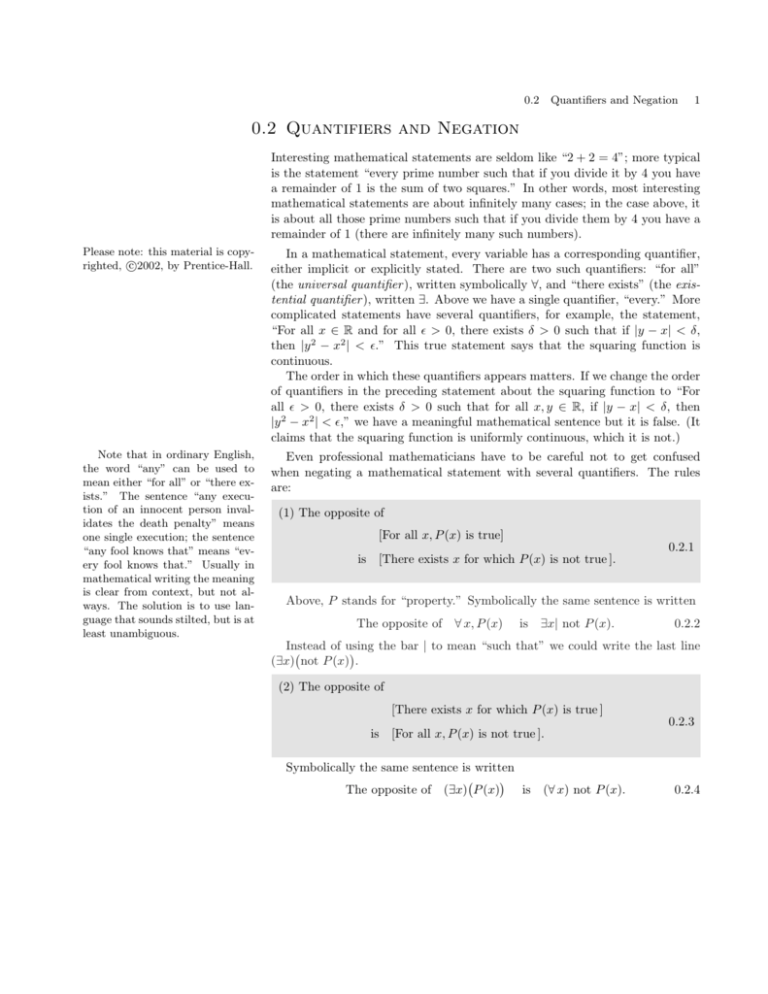
0.2 Quantifiers and Negation 1 0.2 Quantifiers and Negation Interesting mathematical statements are seldom like “2 + 2 = 4”; more typical is the statement “every prime number such that if you divide it by 4 you have a remainder of 1 is the sum of two squares.” In other words, most interesting mathematical statements are about infinitely many cases; in the case above, it is about all those prime numbers such that if you divide them by 4 you have a remainder of 1 (there are infinitely many such numbers). Please note: this material is copyc righted, °2002, by Prentice-Hall. In a mathematical statement, every variable has a corresponding quantifier, either implicit or explicitly stated. There are two such quantifiers: “for all” (the universal quantifier ), written symbolically ∀, and “there exists” (the existential quantifier ), written ∃. Above we have a single quantifier, “every.” More complicated statements have several quantifiers, for example, the statement, “For all x ∈ R and for all ² > 0, there exists δ > 0 such that if |y − x| < δ, then |y 2 − x2 | < ².” This true statement says that the squaring function is continuous. The order in which these quantifiers appears matters. If we change the order of quantifiers in the preceding statement about the squaring function to “For all ² > 0, there exists δ > 0 such that for all x, y ∈ R, if |y − x| < δ, then |y 2 − x2 | < ²,” we have a meaningful mathematical sentence but it is false. (It claims that the squaring function is uniformly continuous, which it is not.) Note that in ordinary English, the word “any” can be used to mean either “for all” or “there exists.” The sentence “any execution of an innocent person invalidates the death penalty” means one single execution; the sentence “any fool knows that” means “every fool knows that.” Usually in mathematical writing the meaning is clear from context, but not always. The solution is to use language that sounds stilted, but is at least unambiguous. Even professional mathematicians have to be careful not to get confused when negating a mathematical statement with several quantifiers. The rules are: (1)inThe opposite of [For all x, P (x) is true] 0.2.1 is [There exists x for which P (x) is not true ]. Above, P stands for “property.” Symbolically the same sentence is written The opposite of ∀ x, P (x) is ∃x| not P (x). 0.2.2 Instead of using the bar | to mean “such that” we could write the last line ¡ ¢ (∃x) not P (x) . (2)inThe opposite of [There exists x for which P (x) is true ] 0.2.3 is [For all x, P (x) is not true ]. Symbolically the same sentence is written ¡ ¢ The opposite of (∃x) P (x) is (∀ x) not P (x). 0.2.4 2 These rules may seem reasonable and simple. Clearly the opposite of the (false) statement, “All rational numbers equal 1,” is the statement, “There exists a rational number that does not equal 1.” Statements that to the ordinary mortal are false or meaningless are thus accepted as true by mathematicians; if you object, the mathematician will retort, “find me a counterexample.” It is often easiest to negate a complicated mathematical sentence using symbolic notation: replace every ∀ by ∃ and vice versa, and then negate the conclusion. For example, to negate Equation 0.2.5, write (∃x)(∃² > 0)(∀δ > 0)(∃y) such that |x − y| < δ and |f (x) − f (y)| ≥ ². Of course one could also negate Equation 0.2.5, or any mathematical statement, by putting “not” in the very front, but that is not very useful when you are trying to determine whether a complicated statement is true. You can also reverse some leading quantifiers, then insert a “not” and leave the remainder as it was. Usually getting the not at the end is most useful: you finally come down to a statement that you can check. The symbol 4 marks the end of an example or remark; the symbol ¤ marks the end of a proof. However, by the same rules, the statement, “All eleven-legged alligators are orange with blue spots” is true, since if it were false, then there would exist a eleven-legged alligator that is not orange with blue spots. The statement, “All eleven-legged alligators are black with white stripes” is equally true. In addition, mathematical statements are rarely as simple as “All rational numbers equal 1.” Often there are many quantifiers, and even the experts have to watch out. At a lecture attended by one of the authors, it was not clear to the audience in what order the lecturer was taking the quantifiers; when he was forced to write down a precise statement, he discovered that he didn’t know what he meant and the lecture fell apart. Example 0.2.1 (Order of quantifiers in defining continuity). In the definitions of continuity and uniform continuity, the order of quantifiers really counts. A function f is continuous if for all x, and for all ² > 0, there exists δ > 0 such that for all y, if |x − y| < δ, then |f (x) − f (y)| < ². That is, f is continuous if (∀x)(∀² > 0)(∃δ > 0)(∀y) such that |x − y| < δ implies |f (x) − f (y)| < ², 0.2.5 which can also be written ³ ´ (∀x)(∀² > 0)(∃δ > 0)(∀y) |x − y| < δ =⇒ |f (x) − f (y)| < ² . 0.2.6 A function f is uniformly continuous if for all ² > 0, there exists δ > 0 for all x and all y such that if |x − y| < δ, then |f (x) − f (y)| < ². That is, f is uniformly continuous if ¡ ¢ (∀² > 0)(∃δ > 0)(∀x)(∀y) |x − y| < δ =⇒ |f (x) − f (y)| < ² . 0.2.7 For the continuous function, we can choose different δ for different x; for the uniformly continuous function, we start with ² and have to find a single δ that works for all x. For example, the function f (x) = x2 is continuous but not uniformly continuous: as you choose bigger and bigger x, you will need a smaller δ if you want the statement |x − y| < δ to imply |f (x) − f (y)| < ², because the function keeps climbing more and more steeply. But sin x is uniformly continuous; you can find one δ that works for all x and all y. 4

